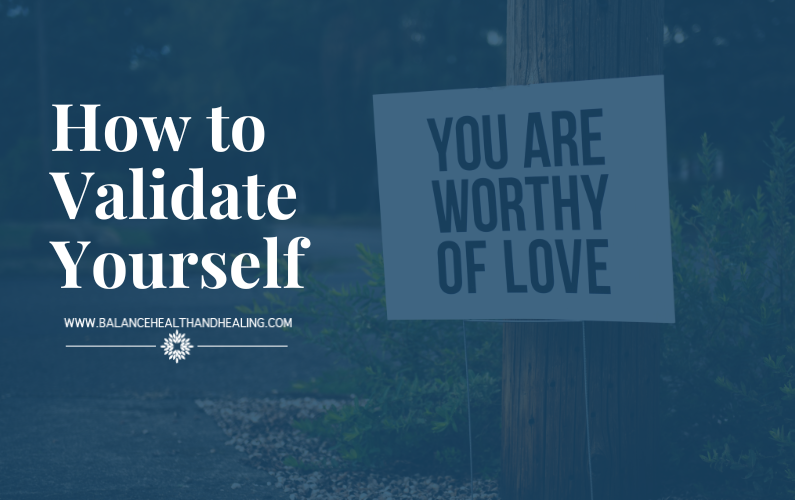
How to Validate Yourself
We all start out trusting ourselves, acting on our intuition, and advocating for our needs. As infants and toddlers we cry when we’re hungry or hurt, we laugh and play when we’re happy, we draw near to people we trust and avoid those we have a bad sense about. As we grow, however, we might start to feel self-conscious about our behavior, wonder if what we’re doing is “normal,” and second guess or even criticize our thoughts, feelings, and behaviors. For many of us, this self-analysis turns into self-doubt and self-invalidation and disconnects us from our needs and intuition about what is best for us.
 This self-invalidation often starts in your environment. You might express some idea, desire, or emotion you have, and an adult in your life responds with, “you’re not sad, you’re fine,” “you’re not hungry, you just ate,” “learning piano’s not for you,” or “no one will like you if you talk about that.” You might have learned it by watching a parent or friend discount their needs or emotional experience, saying, “I shouldn’t be sad” or noticeably controlling their excitement so they don’t look silly. Over time, you start to think this way more and more until you don’t even notice how often you tell yourself to stop being so weak, stop expecting to make good friends, stop thinking you can try for the promotion at work. Eventually, it might become hard even to know who you are and what you want – after all, you’ve spent so much time trying to beat back any spontaneous emotion or thought you have.
This self-invalidation often starts in your environment. You might express some idea, desire, or emotion you have, and an adult in your life responds with, “you’re not sad, you’re fine,” “you’re not hungry, you just ate,” “learning piano’s not for you,” or “no one will like you if you talk about that.” You might have learned it by watching a parent or friend discount their needs or emotional experience, saying, “I shouldn’t be sad” or noticeably controlling their excitement so they don’t look silly. Over time, you start to think this way more and more until you don’t even notice how often you tell yourself to stop being so weak, stop expecting to make good friends, stop thinking you can try for the promotion at work. Eventually, it might become hard even to know who you are and what you want – after all, you’ve spent so much time trying to beat back any spontaneous emotion or thought you have.
Luckily, just as you learned to self-invalidate, you can also learn to do the opposite – validate and honor your internal signals to help you build the life you want to live.
Pay Attention to Your Experience
Psychologist Marsha Linehan explains that the first step of being validating, whether to yourself or others, is to pay attention. It’s easy to see how this would play out in a relationship: if your spouse or friend starts talking, you stop what you are doing, make eye contact, and listen attentively. Applied to yourself, however, it might look like stopping what you are doing and taking a few minutes to be mindful. What emotion are you feeling? How intense is it? What are your thoughts about what’s going on right now? What do you want? Really open up room in your mind and heart to consider what you are experiencing.
Put Your Experience Into Words
Then, reflect to yourself, or put into words, what you are experiencing: “I have a strong craving for ice cream.” “I am feeling irritable.” “I don’t want to attend this social event.” Say this out loud or write it down on paper or your phone. As you start to articulate your experience, you may notice judgmental thoughts come into your mind, like “I don’t deserve a rest,” “I shouldn’t be annoyed by my children,” or “Ugh, I always want ice cream. I’m so pathetic.” Notice those thoughts, notice the urge to stop being open and instead criticize yourself, and then come back to your experience and simply describe what is happening.
Describe How Your Reaction Makes Sense Given the Circumstances
Once you have some awareness of what you are feeling and thinking, describe to yourself why your experience makes sense given your history and current circumstances. For example, “Of course I want ice cream. It’s delicious and tied to happy memories.” “It makes sense that I’m irritable; caring for small children wears most people down.” “Going to social events can be hard after a long work day. Making small talk takes effort and can be awkward.”
Decide How You Would Like to Move Forward
Finally, decide (nonjudgmentally) what the most effective way to move forward is. It may mean eating ice cream as one of your snacks. It may mean calling a babysitter to have some time to yourself. It may mean going to the event because you value connection, even when it’s awkward, or on the other hand, staying home from the event because you are feeling depleted and would like a quiet evening to prepare for the next day. The key here is taking out “should” or “have to,” but instead, taking the valid information from your thoughts and emotions and information from your values and making an effective choice in line with your long-term goals.
Like everything else, self-validation takes practice. But as you continue to pay attention to your own experience, put it into words, look for ways it makes sense, and decide how you want to move forward, you will learn to quiet that critical, invalidating voice and make choices based on what matters most to you.
